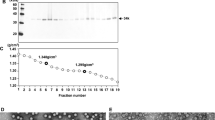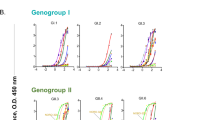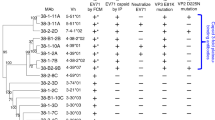Abstract
IN domestic cats, regression of tumours originally induced by inoculation of feline sarcoma virus (FeSV) as well as the resistance to feline leukaemia virus (FeLV)-induced lymphosarcoma in the natural environment are correlated with high titres of antibody to the feline oncornavirus-associated cell membrane antigen (FOCMA)1–4. FOCMA is present on FeLV-producing and nonproducing feline lymphosarcoma (LSA) cells and FeSV-infected fibrosarcoma cells but is absent from FeLV-infected normal cells. This finding is consistent with the interpretation that FOCMA represents an FeLV or FeSV-induced transformation-specific protein5–7. Other workers have initiated studies of the biochemical nature of FOCMA derived from cytoplasmic extracts of cells of a heterologous species (mink) nonproductively transformed by FeSV8–10. However, our primary interest has been to analyse FOCMA expressed on naturally occurring LSA cells from pet cats. We describe here the identification of a hitherto unrecognised protein on the surface of feline LSA cells and cultured transformed feline lymphoblastoid cells which exhibits antigenic determinants in common with FOCMA. The molecular weight of this protein is approximately 70,000. Our data agree with the accumulating evidence that FOCMA is distinct from all FeLV and RD114-coded virion antigens4,6–11.
This is a preview of subscription content, access via your institution
Access options
Subscribe to this journal
Receive 51 print issues and online access
$199.00 per year
only $3.90 per issue
Buy this article
- Purchase on Springer Link
- Instant access to full article PDF
Prices may be subject to local taxes which are calculated during checkout
Similar content being viewed by others
References
Essex, M., Klein, G., Snyder, S. P. & Harrold, J. B. Nature 233, 195–196 (1971).
Essex, M. Adv. Cancer Res. 21, 175–248 (1975).
Essex, M., Sliski, A., Cotter, S. M., Jakowski, R. M. & Hardy, W. D. Jr Science 190, 790–792 (1975).
Hardy, W. D., Jr et al. Cancer Res. 36, 582–588 (1976).
Theilen, G. H., Kawakami, T. G., Rush, J. D. & Munn, R. J. Nature 222, 589–590 (1969).
Hardy, W. D., Jr, Zuckerman, E. E., MacEwen, E. G., Hayes, A. A. & Essex, M. Nature 270, 249–251 (1977).
Essex, M., Cotter, S. M., Stephenson, J. R., Aaronson, S. A. & Hardy, W. D., Jr in Origins of Human Cancer (eds Hiatt, H. H., Watson, J. D. & Winston, J. A.) 1197–1214 (Cold Spring Harbor Laboratory, 1977).
Sliski, A. H., Essex, M., Meyer, M. & Todaro, G. Science 196, 1336–1339 (1977).
Stephenson, J. R., Khan, A. S., Sliski, A. H. & Essex, M. Proc. natn. Acad. Sci. U.S.A. 74, 5608–5612 (1977).
Sherr, C. J., Sen, A., Todaro, G. J., Sliski, A. & Essex, M. Proc. natn. Acad. Sci. U.S.A. 75, 1505–1509 (1978).
Gardner, M. B. et al. Int. J. Cancer 19, 581–589 (1977).
Snyder, H. W., Jr, Stockert, E. & Fleissner, E. J. Virol. 23, 302–314 (1977).
Obata, Y. et al. J. exp. Med. 147, 1089–1105 (1978).
Yoshiki, T., Mellors, R. C., Hardy, W. D., Jr & Fleissner, E. J. exp. Med. 139, 925–942 (1974).
Henderson, I. C., Lieber, M. M. & Todaro, G. Virology 60, 282–287 (1974).
Fleissner, E. J. Virol. 8, 778–785 (1971).
Hardy, W. D., Jr, Hirshaut, Y. & Hess, P. in Unifying Concepts of Leukemia (eds Dutcher, R. M. & Chieco-Bianchi, L.) 778–799 (Karger, Basel, 1973).
Laemmli, U. K. Nature 247, 680–685 (1970).
Author information
Authors and Affiliations
Rights and permissions
About this article
Cite this article
SNYDER, H., HARDY, W., ZUCKERMAN, E. et al. Characterisation of a tumour-specific antigen on the surface of feline lymphosarcoma cells. Nature 275, 656–658 (1978). https://doi.org/10.1038/275656a0
Received:
Accepted:
Issue Date:
DOI: https://doi.org/10.1038/275656a0
Comments
By submitting a comment you agree to abide by our Terms and Community Guidelines. If you find something abusive or that does not comply with our terms or guidelines please flag it as inappropriate.



